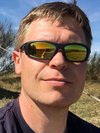Organisches Oberflächengeochemie Labor (OSGLab)
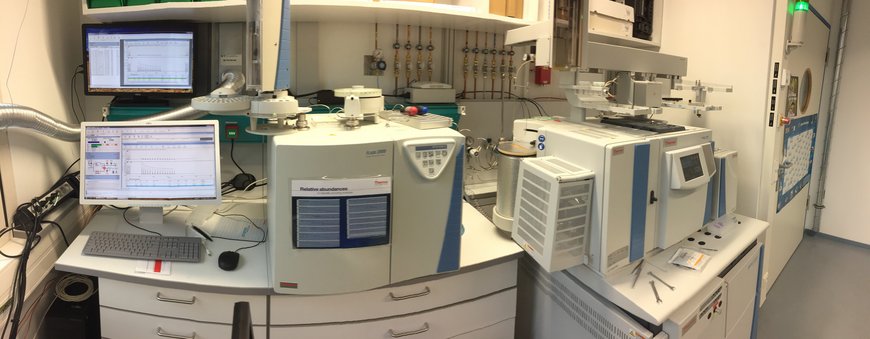
Im organischen Oberflächengeochemie Labor (OSGLab) der Sektion Geomorphologie dienen kleinste Moleküle und Isotope als Schlüssel zur Vergangenheit. Im OSGLab erforschen wir insbesondere die regionalen Unterschiede der Ursachen und Auswirkungen vergangener Klimawandel und Veränderungen in biogeochemischen Kreisläufen. In einigen Projekten können wir die „Spuren“ des Klimawandels auf das Jahrzehnt genau bestimmen, in anderen Projekten werden biogeochemische Prozesse über Jahrmillionen zurückverfolgt.
Postdocs
- Xinxin Wang
Doktorand*innen
- Charlotte Läuchli
- Nestor Gaviria
- Sophia Dosch
- Theresa Grunwald
Techniker*innen und wissenschaftliche Hilfskräfte
- Jasmin Jenichen
Bachelor- und Masterstudent*innen
- Emily Ikawy
- Louisa Kanis
Im neuen Labor lassen sich Veränderungen im Kreislauf des Kohlenstoffs über sogenannte Biomarker aus Pflanzen und Mikroorganismen rekonstruieren. Biomarker sind resistente organische Moleküle, die man einem Organismus zuordnen kann. Über ihre charakteristischen Strukturen zeigen sie, von welcher Pflanze oder Alge sie gebildet wurden. Pflanzenteile gelangen über Böden und Flüsse in Seen und Meere und lagern sich dort in Sedimenten ab. Über die Jahrtausende zersetzen sich die Pflanzenteile, ihre Biomarker aber bleiben zurück, sie werden sozusagen zu molekularen Fossilien. Wir beproben die Sedimente und untersuchen die darin enthaltenen Biomarker im Labor.
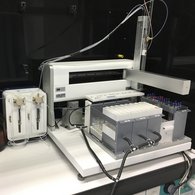
Automatisierte Festphasenextraktion (aSPE)
Das nach der Lösemittelextraktion aus der Probe gewonnene Total-Liquid-Extrakt (TLE) wird mittels einer automatisierten Festphasenextraktion (Solid-Phase-Extraction-SPE) über einen Lösemittelgradienten verschiedener Polarität in mehrere Fraktionen unterschiedlicher Komponentenzusammensetzungen aufgetrennt. Der Festphasenautomat (Gilson ASPEC GX-271) kann pro Lauf mit 9 Proben bestückt werden, die völlig automatisch in bis zu 5 verschieden Fraktionen separiert werden können. Für die Auftrennung werden 6 ml Standardglassäulen, die mit bis zu 5,5 ml Silicagel befüllt sind, verwendet. Die mit Proben bestückten Säulen können mit Volumina von bis zu 20 ml Lösemittel gespült werden. https://doi.org/10.1016/j.orggeochem.2020.103995
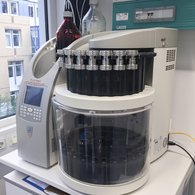
Beschleunigte Lösemittelextraktion (ASE)
Die Extraktion der Biomarker aus den Proben/Sedimenten erfolgt mittels einer beschleunigten Lösemittelextraktion (Accelerated Solvent Extraction – ASE 350) der Firma ThermoFisher. Um eine möglichst effektive Extraktion bei geringen Lösemitteleinsatz und variierenden Sediment- bzw. Probenmengen zu gewährleisten, stehen Extraktionszellen in verschiedenen Größen zur Verfügung (11-60 ml). Das Gerät kann mit maximal 24 Extraktionszellen pro Durchlauf bestückt werden.
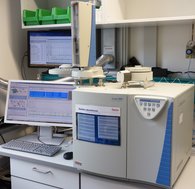
Elementanalysator mit Delta-V Isotopenmassenspektrometer (EA-IRMS)
Für die quantitative Kohlenstoff- und Stickstoffanalyse an Bulkproben wird im Labor ein Flash Elementaranalysator 2000 (Flash EA 2000) von ThermoFisher Scientific ausgerüstet mit einem Thermal-Leitfähigkeitsdetektor (TCD) verwendet. Für die Messungen stabiler Kohlenstoff-(δ13C) und Stickstoffisotopenverhältnisse (δ15N) an Bulkproben wird der Flash EA 2000 mit einem Delta-V Isotopenmassenspektrometer gekoppelt. Die Messung stabiler Wasserstoff-(δ2H) und Sauerstoffisotopenverhältnisse (δ18O) an Wasserproben kann ebenfalls mit dem Flash EA 2000 durchgeführt werden, da das Gerät zusätzlich mit einem Flüssig-Autosampler ausgestattet ist. Die Flash EA 2000 Wasseranalyse wird vorrangig bei verschmutzen und besonders salzhaltigen Wasserproben eingesetzt.
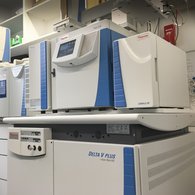
Gaschromatograph mit Delta-V Isotopenmassenspektrometer (GC-IRMS)
Für die komponentenspezifische Analyse stabiler Wasserstoff-(δ2H) und Kohlenstoffisotopenverhältnisse (δ13C) an organischen Molekülen steht ein ThermoFisher Scientific Gaschromatograf (Trace 1310) gekoppelt mit einem Delta-V Isotopenmassenspektrometer im Labor zu Verfügung. Das Gerät ist mit einem TriPlus RSH Autosampler für Flüssig- sowie Headspace-injektionen ausgestattet sowie einem Heizreservoir für lokale Derivatisierungen. Die ‚Bottom-sense’ Technologie des Autosamplers ermöglich die automatisierte Injektion von Proben mit sehr geringer Komponentenkonzentration.
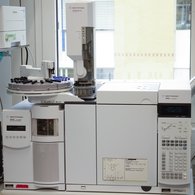
Gaschromatograph mit Flammenionisations - und Massenselektivem Detektor (GC-FID-MS)
Für die Quantifizierung und Identifikation der in den Fraktionen enthaltenden organischen Substanzen steht im Labor ein Agilent Gaschromatograph (GC 7890-A) mit einem Flammenionisationsdetektor (FID) und einem gekoppelten Single-Quadrupole Massenspektrometer (MS 5975-C) zur Verfügung. Das Gerät verfügt über einen Autosampler mit 100 Probenplätzen und kann nach probenspezifischen Anforderungen kurzfristig mit verschiedenen Trennsäulen bestückt werden.
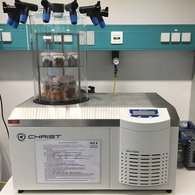
Gefriertrocknung
Das Labor verfügt über eine Christ Beta 1-8 LDplus Gefriertrocknungsanlage mit einer Eiskondensatorkapazität von 8kg und einer Eiskondensatortemperatur von -55°C. Diese Anlage wird verwendet um Proben, die für die Biomarkeranalyse vorgesehen sind, von überschüssigem Wasser zu befreien.
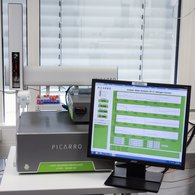
Picarro L-2140i
Die Messung stabiler Wasserstoff-(δ2H) und Sauerstoffisotopenverhältnisse (δ18O und δ17O) an Wasserproben wird im Labor sehr zeiteffizient mit einem Picarro L-2140i Ringdown Spektrometer durchgeführt.

Semipräparativer Hochleistungs-Flüssigchromatograph mit massenselektivem Detektor (HPLC-MS)
Für die Identifikation, Separation und Quantifizierung komplexer organischer Moleküle steht ein semi-präparatives Agilent Infinity HPLC-MS (Single-Quadrupole) System mit wahlweise einer APCI (Atmospheric Pressure Chemical Ionization) oder ESI (Electro-Spray-Ionization) Quelle zur Verfügung. Über einen angeschlossenen Fraktionssammler können einzelne Moleküle für weitere Analysen getrennt gesammelt und aufkonzentriert werden.
2021
- Goldberg, T., Hennekam, R., Wasch, L., Reichart, G.-J., Rach, O., Stammeier, J. A., Griffioen, J. (2021): Suitability of calibrated X-ray fluorescence core scanning for environmental geochemical characterisation of heterogeneous sediment cores. - Applied Geochemistry, 125, 104824. DOI: https://doi.org/10.1016/j.apgeochem.2020.104824
2020
- Dietze, E., Mangelsdorf, K., Andreev, A., Karger, C., Schreuder, L. T., Hopmans, E. C., Rach, O., Sachse, D., Wennrich, V., Herzschuh, U. (2020): Relationships between low-temperature fires, climate and vegetation during three late glacials and interglacials of the last 430 kyr in northeastern Siberia reconstructed from monosaccharide anhydrides in Lake El’gygytgyn sediments. - Climate of the Past, 16, 799-818. DOI: https://doi.org/10.5194/cp-16-799-2020
- Menges, J., Hovius, N., Andermann, C., Lupker, M., Haghipour, N., Märki, L., Sachse, D. (2020): Variations in organic carbon sourcing along a trans-Himalayan river determined by a Bayesian mixing approach. - Geochimica et Cosmochimica Acta, 286, 159-176. DOI: https://doi.org/10.1016/j.gca.2020.07.003
- Rach, O., Hadeen, X., Sachse, D. (2020): An automated solid phase extraction procedure for lipid biomarker purification and stable isotope analysis. - Organic Geochemistry, 142, 103995. DOI: https://doi.org/10.1016/j.orggeochem.2020.103995
- van der Veen, I., Peterse, F., Davenport, J., Meese, B., Bookhagen, B., France-Lanord, C., Kahmen, A., Hassenruck–Gudipati, H. J., Gajurel, A., Strecker, M. R., Sachse, D. (2020): Validation and calibration of soil δ2H and brGDGTs along (E-W) and strike (N-S) of the Himalayan climatic gradient. - Geochimica et Cosmochimica Acta, 290, 408-423. DOI: https://doi.org/10.1016/j.gca.2020.09.014
- Voss, K. A., Bookhagen, B., Sachse, D., Chadwick, O. A. (2020): Variation of deuterium excess in surface waters across a 5000-m elevation gradient in eastern Nepal. - Journal of Hydrology, 586, 124802. DOI: https://doi.org/10.1016/j.jhydrol.2020.124802
2019
- Aichner, B., Makhmudov, Z., Rajabov, I., Zhang, Q., Pausata, F. S. R., Werner, M., Heinecke, L., Kuessner, M. L., Feakins, S. J., Sachse, D., Mischke, S. (2019): Hydroclimate in the Pamirs Was Driven by Changes in Precipitation‐Evaporation Seasonality Since theLast Glacial Period. - Geophysical Research Letters, 46, 23, 13972-13983. DOI: https://doi.org/10.1029/2019GL085202
- Menges, J., Hovius, N., Andermann, C., Dietze, M., Swoboda, C., Cook, K., Adhikari, B. R., Vieth-Hillebrand, A., Bonnet, S., Reimann, T., Koutsodendris, A., Sachse, D. (2019): Late Holocene landscape collapse of a Trans‐Himalayan dryland: Human impact and aridification. - Geophysical Research Letters, 46, 23, 13814-13824. DOI: https://doi.org/10.1029/2019GL084192
- Scheingross, J., Hovius, N., Dellinger, M., Hilton, R. G., Repasch, M., Sachse, D., Gröcke, D. R., Vieth-Hillebrand, A., Turowski, J. (2019): Preservation of organic carbon during active fluvial transport and particle abrasion. - Geology, 47, 10, 958-962. DOI: https://doi.org/10.1130/G46442.1
2018
- Aichner, B., Ott, F., Słowiński, M., Noryśkiewicz, A. M., Brauer, A., Sachse, D. (2018): Leaf wax n-alkane distributions record ecological changes during the Younger Dryas at Trzechowskie paleolake (northern Poland) without temporal delay. - Climate of the Past, 14, 11, 1607-1624. DOI: https://doi.org/10.5194/cp-14-1607-2018
- Regenspurg, S., Alawi, M., Norden, B., Vieth-Hillebrand, A., Blöcher, G., Kranz, S., Scheytt, T., Horn, F., Burckhardt, O., Rach, O., Saadat, A. (2020): Effect of cold and hot water injection on the chemical and microbial composition of an aquifer and implication for its use as an aquifer thermal energy storage. - Geothermics, 84, 101747. DOI: https://doi.org/10.1016/j.geothermics.2019.101747
- Jones, G., Lane, C. S., Brauer, A., Davies, S. M., de Bruijn, R., Engels, S., Haliuc, A., Hoek, W. Z., Merkt, J., Sachse, D., Turner, F., Wagner-Cremer, F. (2018): The Lateglacial to early Holocene tephrochronological record from Lake Hämelsee, Germany: a key site within the European tephra framework. - Boreas, 47, 1, pp. 28-40. DOI: http://doi.org/10.1111/bor.12250
2017
- Rach, O., Engels, S., Kahmen, A., Brauer, A., Martin-Puertas, C., van Geel, B., Sachse, D. (2017): Hydrological and ecological changes in western Europe between 3200 and 2000 years BP derived from lipid biomarker δD values in lake Meerfelder Maar sediments. - Quaternary Science Reviews, 172, pp. 44-54. DOI: http://doi.org/10.1016/j.quascirev.2017.07.019
- Aichner, B., Hilt, S., Périllon, C., Gillefalk, M., Sachse, D. (2017): Biosynthetic hydrogen isotopic fractionation factors during lipid synthesis in submerged aquatic macrophytes: Effect of groundwater discharge and salinity. - Organic Geochemistry, 113, pp. 10-16. DOI: http://doi.org/10.1016/j.orggeochem.2017.07.021
- Nelson, D. B., Knohl, A., Sachse, D., Schefuß, E., Kahmen, A. (2017): Sources and abundances of leaf waxes in aerosols in central Europe. - Geochimica et Cosmochimica Acta, 198, pp. 299-314. DOI: http://doi.org/10.1016/j.gca.2016.11.018
- Rach, O., Kahmen, A., Brauer, A., Sachse, D. (2017): A dual-biomarker approach for quantification of changes in relative humidity from sedimentary lipid D/H ratios. - Climate of the Past, 13, 7, pp. 741-757. DOI: http://doi.org/10.5194/cp-13-741-2017
- Hernández, M. A., Gleixner, G., Sachse, D., Alvarez, H. M. (2017): Carbon Allocation in Rhodococcus jostii RHA1 in Response to Disruption and Overexpression of nlpR Regulatory Gene, Based on 13C-labeling Analysis. - Frontiers in Microbiology. DOI: http://doi.org/10.3389/fmicb.2017.01992
- Vögeli, N., Najman, Y., van der Beek, P., Huyghe, P., Wynn, P. M., Govin, G., van der Veen, I., Sachse, D. (2017): Lateral variations in vegetation in the Himalaya since the Miocene and implications for climate evolution. - Earth and Planetary Science Letters, 471, pp. 1-9. DOI: http://doi.org/10.1016/j.epsl.2017.04.037
2016
- Engels, S., Brauer, A., Buddelmeijer, N., Martin-Puertas, C., Rach, O., Sachse, D., van Geel, B. (2016): Subdecadal-scale vegetation responses to a previously unknown late-Allerød climate fluctuation and Younger Dryas cooling at Lake Meerfelder Maar (Germany). - Journal of Quaternary Science, 31, 7, pp. 741-752. DOI: http://doi.org/10.1002/jqs.2900
- Engels, S., Bakker, M., Bohncke, S., Cerli, C., Hoek, W., Jansen, B., Peters, T., Renssen, H., Sachse, D., van Aken, J., van den Bos, V., van Geel, B., van Oostrom, R., Winkels, T., Wolma, M. (2016): Centennial-scale lake-level lowstand at Lake Uddelermeer (The Netherlands) indicates changes in moisture source region prior to the 2.8-kyr event. - Holocene, 26, 7, pp. 1075-1091. DOI: http://doi.org/10.1177/0959683616632890
- Gamarra, B., Sachse, D., Kahmen, A. (2016): Effects of leaf water evaporative 2H-enrichment and biosynthetic fractionation on leaf wax n-alkane δ2H values in C3 and C4 grasses . - Plant Cell and Environment, 39, 11, pp. 2390-2403. DOI: http://doi.org/10.1111/pce.12789
- Hoffmann, B., Feakins, S. J., Bookhagen, B., Olen, S. M., Adhikari, D. P., Mainali, J., Sachse, D. (2016): Climatic and geomorphic drivers of plant organic matter transport in the Arun River, E Nepal. - Earth and Planetary Science Letters, 452, pp. 104-114. DOI: http://doi.org/10.1016/j.epsl.2016.07.008
- Jambrina-Enríquez, M., Sachse, D., Valero-Garcés, B. L. (2016): A deglaciation and Holocene biomarker-based reconstruction of climate and environmental variability in NW Iberian Peninsula: the Sanabria Lake sequence. - Journal of Paleolimnology, 56, 1, pp. 49-66. DOI: http://doi.org/10.1007/s10933-016-9890-6
- Nieto-Moreno, V., Rohrmann, A., van der Meer, M. T. J., Sinninghe Damsté, J. S., Sachse, D., Tofelde, S., Niedermeyer, E. M., Strecker, M. R., Mulch, A. (2016): Elevation-dependent changes in n-alkane δD and soil GDGTs across the South Central Andes. - Earth and Planetary Science Letters, 453, pp. 234-242. DOI: http://doi.org/10.1016/j.epsl.2016.07.049
- Rohrmann, A., Sachse, D., Mulch, A., Pingel, H., Tofelde, S., Alonso, R. N., Strecker, M. R. (2016): Miocene orographic uplift forces rapid hydrological change in the southern central Andes. - Scientific Reports, 6, 35678. DOI: http://doi.org/10.1038/srep35678
- Wang, X., Huang, X., Sachse, D., Hu, Y., Xue, J., Meyers, P. A. (2016): Comparisons of lipid molecular and carbon isotopic compositions in two particle-size fractions from surface peat and their implications for lipid preservation. - Environmental Earth Sciences, 75, 1142. DOI: http://doi.org/10.1007/s12665-016-5960-3
- Wang, X., Huang, X., Sachse, D., Ding, W., Xue, J., Zhu, L. (2016): Molecular Paleoclimate Reconstructions over the Last 9 ka from a Peat Sequence in South China. - Plos One, 11, 9. DOI: http://doi.org/10.1371/journal.pone.0160934
2015
- Olen, S. M., Bookhagen, B., Hoffmann, B., Sachse, D., Adhikari, D. P., Strecker, M. R. (2015): Understanding erosion rates in the Himalayan orogen: A case study from the Arun Valley. - Journal of Geophysical Research, 120, 10, pp. 2080-2102. DOI: http://doi.org/10.1002/2014JF003410
- Riedel, N., Stebich, M., Anoop, A., Basavaiah, N., Menzel, P., Prasad, S., Sachse, D., Sarkar, S., Wiesner, M. (2015): Modern pollen vegetation relationships in a dry deciduous monsoon forest: A case study from Lonar Crater Lake, central India. - Quaternary International, 371, pp. 268-279. DOI: http://doi.org/10.1016/j.quaint.2015.01.046
- Sachse, D., Dawson, T. E., Kahmen, A. (2015): Seasonal variation of leaf wax n-alkane production and δ H-2 values from the evergreen oak tree, Quercus agrifolia . - Isotopes in environmental and health studies, 51, pp. 124-142. DOI: http://doi.org/10.1080/10256016.2015.1011636
- Sarkar, S., Prasad, S., Wilkes, H., Riedel, N., Stebich, M., Basavaiah, N., Sachse, D. (2015): Monsoon source shifts during the drying mid-Holocene: Biomarker isotope based evidence from the core ‘monsoon zone’ (CMZ) of India. - Quaternary Science Reviews, 123, pp. 144-157. DOI: http://doi.org/10.1016/j.quascirev.2015.06.020
- Sachse, D. (2015): Molekulare Indikatoren für die Wasser- und Kohlenstoffkreisläufe der Erde. - System Erde, 5, 1 DOI: http://doi.org/10.2312/GFZ.syserde.05.01.3
2014
- Menges, J., Huguet, C., Alcañiz, J. M., Fietz, S., Sachse, D., Rosell-Melé, A. (2014): Influence of water availability in the distributions of branched glycerol dialkyl glycerol tetraether in soils of the Iberian Peninsula. - Biogeosciences, 11, pp. 2571-2581. DOI: http://doi.org/10.5194/bg-11-2571-2014
- Rohrmann, A., Strecker, M. R., Bookhagen, B., Mulch, A., Sachse, D., Pingel, H., Alonso, R. N., Schildgen, T., Montero, C. (2014): Can stable isotopes ride out the storms? The role of convection for water isotopes in models, records, and paleoaltimetry studies in the central Andes. Earth and Planetary Science Letters, 407, pp. 187-195. DOI: http://doi.org/10.1016/j.epsl.2014.09.021
- Rach, O., Brauer, A., Wilkes, H., Sachse, D. (2014): Delayed hydrological response to Greenland cooling at the onset of the Younger Dryas in western Europe. - Nature Geoscience, 7, 2, pp. 109-112. DOI: http://doi.org/10.1038/ngeo2053


